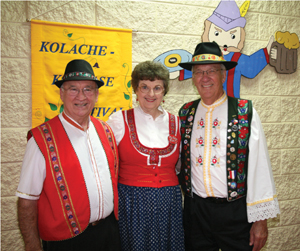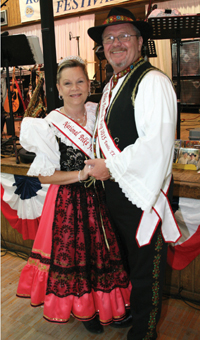
Dennis and Martha Victori with Marvin Adamek at the annual Czech Kolache-Klobase Festival in 2015.
A LITTLE PIECE OF HISTORY | By Joan Frances –
When settlers came to live along the Brazos River in Fort Bend County in the early 1820s, the 300 families who received land grants from the Spanish Government had one thing in common: They were all a part of the Anglo-American colonization of Texas. This vague classification did not define the depth of nationalities that began to set roots and share in the multicultural heritage and traditions among the settlers.
By the time the British arrived in the New World, Spanish settlers already inhabited much of Texas. Along with Portugal, Spain dominated New World exploration and settled in Texas for a time. They left a deep mark of cultural diversity. The Spanish language influenced the names for many of the rivers, towns and counties that still exist, and Spanish architecture is still prevalent. Natives of Ireland were among the first settlers of Spanish-ruled Texas. Four signed the Texas Declaration of Independence, and at least 100 were listed on the rolls at San Jacinto. In fact, many Irish were part of the original Old Three Hundred.
When Fort Bend began to grow and plantation economies developed, African American slaves were widespread. By the 1850s, Fort Bend was one of six counties in the state with a majority African American population. By 1860, Fort Bend’s slave population was 4,127, more than twice the white population of 2,016. After slavery was abolished, many African Americans remained in the Rosenberg and Richmond areas.
By the 1900s, cultures that led to the state’s diversity included Chinese, Japanese, Mexican, Swiss, Syrian, Lebanese, Polish, French, Italian, Greek, Jewish, African American, Belgian, Indian, German, Norwegian, Spanish and Czech Texans. Along with sharing religious beliefs, business practices and traditions, residents took pride in sharing the unique food preparation of these cultures.

Deborah and Michael Loque.
Today, numerous cultures commemorate their heritage in some celebratory fashion throughout the area. Early German colonists hosted festivals with beer, sausage, waltzes and polka bands, and the tradition continues today with Wurstfest and Octoberfest celebrations. Tortillas, tacos and enchiladas were a gift from Mexican citizens, and Cinco de Mayo is the day of praise. The Italians brought pizza, pasta and red wine and continue to celebrate during religious holidays. Korean and Vietnamese residents brought dishes that are still sampled at Asian-American festivals. The Chinese shared fried rice and egg rolls, and the Chinese New Year is celebrated as a day of thanks. Greek festivals today boast delectable gyros, souvlaki, lamb, spanakopita, pastitso and more.
One event Fort Bend residents highly anticipate is the annual Czech Kolache-Klobase Festival held in East Bernard. As early as 1882, Czech immigrants came to the Fort Bend area optimistic and determined to start a new life. They settled near Germans and Poles with whom they shared tastes in food, music and politics. Czechs are very loyal to their traditions, teaching the language to their families and remaining devout Catholics.
For the past 26 years, East Bernard has hosted the Czech Kolache-Klobase Festival to share the traditions and food with the public. This year’s festivities will take place from 10:30 am to 8 pm on Saturday, June 11th at Riverside Hall in East Bernard. “Kolache,” which means “pocket,” is the term for the famous circular tart made of double-risen dough with a center topped or filled with a sweet sauce made of cottage cheese, prunes, peaches or other fruit filling.
One of the fastest growing counties in the country, Fort Bend is home to over 685,000 people of many different cultures. Every ethnic community is respected and appreciated. With such remarkable support, sharing its multicultural heritage will continue for years to come.